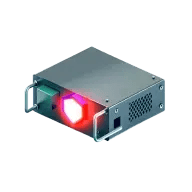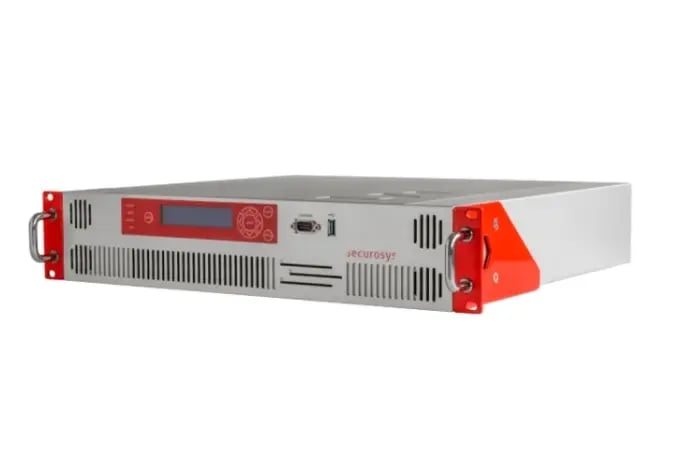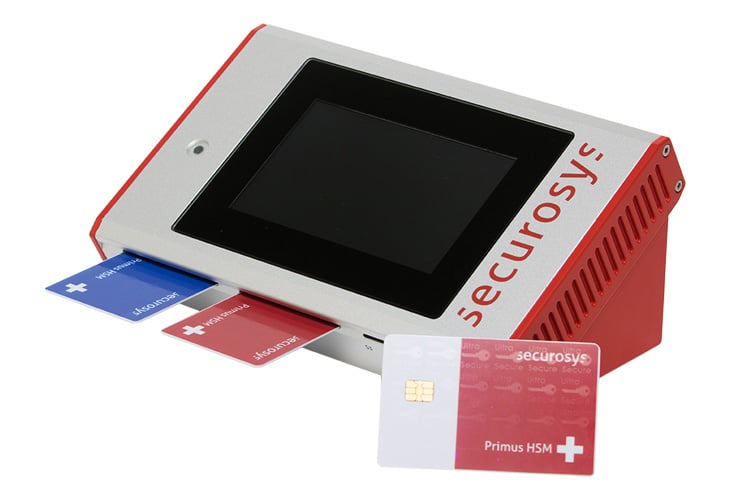HSM Primus X Cyber Vault


Challenge
As quantum computing progresses, it poses challenges for traditional public key cryptographic algorithms, potentially jeopardizing the security of sensitive data. Quantum computers outperform conventional computers in reconstructing the cryptographic key pairs that protect your data. Therefore, organizations might start thinking about developing migration strategies toward upgrading authentication and encryption technologies to make the algorithms and protocols quantum-proof algorithms and ensure the security of their operations.
.webp?length=1920&name=Image%20(1).webp)
Solution
Being prepared for the future is one thing, implementing quantum-readiness another. Transitioning to these new algorithms requires careful preparation and early execution to allow ample time for testing and minimizing disruptions. Yet, the migration and setup of a new device needs to be straightforward. This is where the HSM Primus X Cyber Vault steps in as a crucial solution.
By facilitating hybrid signatures that seamlessly integrate both classical and post-quantum cryptographic algorithms, Cyber Vault ensures a smooth transition process. It offers a comprehensive approach by supporting the integration of RSA or ECC/ED with PQC signatures, AES encryption/decryption, and key exchange protocols. The focus on balanced performance ensures that efficiency is maintained throughout the transition period, safeguarding the integrity of sensitive data in the face of evolving cyber threats.
.webp?length=1920&name=Image%20(1).webp)
Key Benefits






-1.webp?length=1920&name=image%20(1)-1.webp)
Hybrid Operations
Our approach to a save transition to PQC stands out by incorporating hybrid signatures that utilize both classical and PQC algorithms while maintaining consistent throughput. This comprehensive approach supports the integration of RSA or ECC/ED with PQC signatures like Kyber, Dilithium, or SPHINCS+, AES encryption/decryption, and key exchange protocols.
Optical Interface for Seamless Integration
Easily integrate into any network environment with support for copper and optical interfaces up to 10 Gbps.
Market-Leading Performance
The Primus X Cyber Vault sets itself apart as the fastest HSM on the market, handling over 50,000 concurrent transactions per second (TPS). It can be scaled to over 1,000,000 concurrent transactions per second in clustered environments, impressively demonstrating its undisputed pioneering role.
Adaptability
The versatility of the Primus X Cyber Vault makes it the top choice for securing high-volume financial transactions, blockchain systems, crypto asset management, and more.
Use Cases
 Secure Financial Transactions
The Primus X Cyber Vault offers robust security features that make it an ideal choice for securing large volumes of financial transactions. Its advanced encryption capabilities ensure the confidentiality and integrity of sensitive financial data, while the keys are securely generated, distributed and stored within Primus X Cyber Vault.
Secure Financial Transactions
The Primus X Cyber Vault offers robust security features that make it an ideal choice for securing large volumes of financial transactions. Its advanced encryption capabilities ensure the confidentiality and integrity of sensitive financial data, while the keys are securely generated, distributed and stored within Primus X Cyber Vault.
 Blockchain Systems and Crypto Asset Management
With the rise of blockchain technology and crypto assets, the Primus X Cyber Vault provides essential security measures to safeguard digital assets and transactions. Its support for post-quantum cryptography (PQC) ensures future-proof protection against emerging quantum computer threats, while its seamless integration with blockchain systems facilitates secure crypto asset management.
Learn more
Blockchain Systems and Crypto Asset Management
With the rise of blockchain technology and crypto assets, the Primus X Cyber Vault provides essential security measures to safeguard digital assets and transactions. Its support for post-quantum cryptography (PQC) ensures future-proof protection against emerging quantum computer threats, while its seamless integration with blockchain systems facilitates secure crypto asset management.
Learn more
 Zero Trust Networking
The Primus X Cyber Vault enables Zero Trust Networking by authenticating and securing every connection using TLS crypto-offloading. Its utilization of containerized/virtualized architectures enhances security and scalability, making it a trusted solution for implementing Zero Trust principles across network environments.
Learn more
Zero Trust Networking
The Primus X Cyber Vault enables Zero Trust Networking by authenticating and securing every connection using TLS crypto-offloading. Its utilization of containerized/virtualized architectures enhances security and scalability, making it a trusted solution for implementing Zero Trust principles across network environments.
Learn more
 Managed Service and Cloud Providers (MSPs and MCPs)
The Primus X Cyber Vault offers support for multi-tenancy, making it an ideal solution for MSPs and MCPs serving multiple clients. Its scalable performance and seamless integration capabilities enable MSPs and MCPs to securely manage cryptographic keys and provide encryption services to their clients, ensuring data security and compliance with regulatory requirements.
Learn more
Managed Service and Cloud Providers (MSPs and MCPs)
The Primus X Cyber Vault offers support for multi-tenancy, making it an ideal solution for MSPs and MCPs serving multiple clients. Its scalable performance and seamless integration capabilities enable MSPs and MCPs to securely manage cryptographic keys and provide encryption services to their clients, ensuring data security and compliance with regulatory requirements.
Learn more
 Cloud Encryption Solutions
Organizations leveraging cloud platforms such as Azure, AWS, and Google Cloud can rely on the Primus X Cyber Vault for ensuring data sovereignty and security. Its scalable performance, geo-redundancy features, and support for managed service providers make it a versatile choice for encrypting data stored in the cloud, safeguarding it from unauthorized access and breaches.
Learn more
Cloud Encryption Solutions
Organizations leveraging cloud platforms such as Azure, AWS, and Google Cloud can rely on the Primus X Cyber Vault for ensuring data sovereignty and security. Its scalable performance, geo-redundancy features, and support for managed service providers make it a versatile choice for encrypting data stored in the cloud, safeguarding it from unauthorized access and breaches.
Learn more
Technical Specifications
- Multi-barrier software and hardware architecture with supervision mechanisms
- Secure supply-chain
Authentication (extract)
- 128/192/256-bit AES with GCM-, CTR-, ECB-, CBC-, MAC Mode
- Camellia, ChaCha20-Poly1305, ECIES
- RSA 1024-8192, DSA 1024-8192
- ECDSA 224-521, GF(P) arbitrary curves (NIST, Brainpool, ...)
- ED25519, Curve25519
- Diffie-Hellman 1024, 2048, 4096, ECDH
- SHA-2/SHA-3 (224 - 512), SHA-1, RIPEMED-160, Keccak
- HMAC, CMAC, GMAC, Poly 1305
- Post-Quantum Cryptographic (PQC) algorithms
ML-DSA, SLH-DSA, ML-KEM, HSS-LMS, XMSS
- Two hardware true random number generators (TNRG)
- NIST SP800-90 compatible random number generator
- Key capacity up to 30 GB
- Up to 1,000 partitions
- Number of client connections not restricted
- Unlimited number of backups
- Cryptographic evidence of audit relevant parameters
(keys configuration hardware states logs time-stamping)
- Multiple security officers (m out of n)
- Identification based on smart card and PIN
- JCE/JCA Provider
- PKCS#11 provider, OpenSSLv3
- Microsoft CNG/KSP
- REST (TSB module)
- IPv4/IPv6
- Interface bonding (LACP or active/backup)
- Active clustering of multiple units for load-balancing and fail-over
- Monitoring and log streaming (SNMPv2, syslog/TLS)
- Local configuration (GUI, Console)
- Remote administration (Decanus Terminal)
- Local and remote firmware update
- Network attached storage data transfer (WebDAV)
- Secure log and audit
- Enhanced diagnostic functions
(transactions per second)
| Model | RSA 4096 |
RSA 3072 | RSA 2048 |
ECC256 |
| X2P RSA | 2’000 | 5’000 | 12’000 | 15’000 |
| ECC521 | ECC384 | ECC256 | ||
| X2P RSA | 10’000 | 15’000 | 30’000 |
- Two redundant power supplies, hot pluggable:
100 ... 240 V AC, 50 ... 60 Hz - Power dissipation:
65 W (typ.), 100 W (max.) - Backup lithium battery:
Lithium Thionyl Chloride 0.65g Li, IEC 60086-4, UL 1642, 3.6V
- 4 Ethernet RJ-45 ports with 1 Gbps (rear)
- 2 SFP+ slots for optical 10Gbps Ethernet modules (rear)
- 2 Console ports (RJ45, front/rear)
- 2 USB-A management ports (front/rear)
- 1 USB-C management port (rear)
- 3 Smart card slots
- 3 slots for Securosys security smart cards
- 4 LEDs for system and interface status (multicolor)
- Touch screen for configuration
- Console interface
- Optional Decanus Terminal for remote administration
- EMV/EMC: EN 55022, EN 55024, FCC Part 15 Class B
- Safety: IEC 62368-1
- Temperature ranges (IEC 60068-2-1 Ad, IEC 60068-2-2 Bd):
storage -20 ... +60 °C; operation 0 ... +35 °C - Temperature ranges (IEC 60068-2-1 Ad, IEC 60068-2-2 Bd):
storage -20 ... +60 °C; operation 0 ... +35 °C - MTBF (RIAC-HDBU-217Plus) at tamb=25 °C:
>100 000 h - Dimensions (w×h×d) 417 x 44 x 365 mm (1U 19" EIA standard rack)
- Weight 7.5 kg
- FIPS140-3 Level 3 (in progress)
- CC EN 419221-5 eIDAS protection profile (in progress)
-
CC EN 419241-2 Sole Control (SAM)
- CE, FCC, UL













